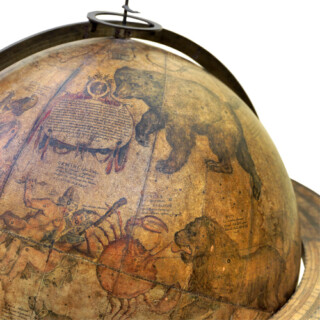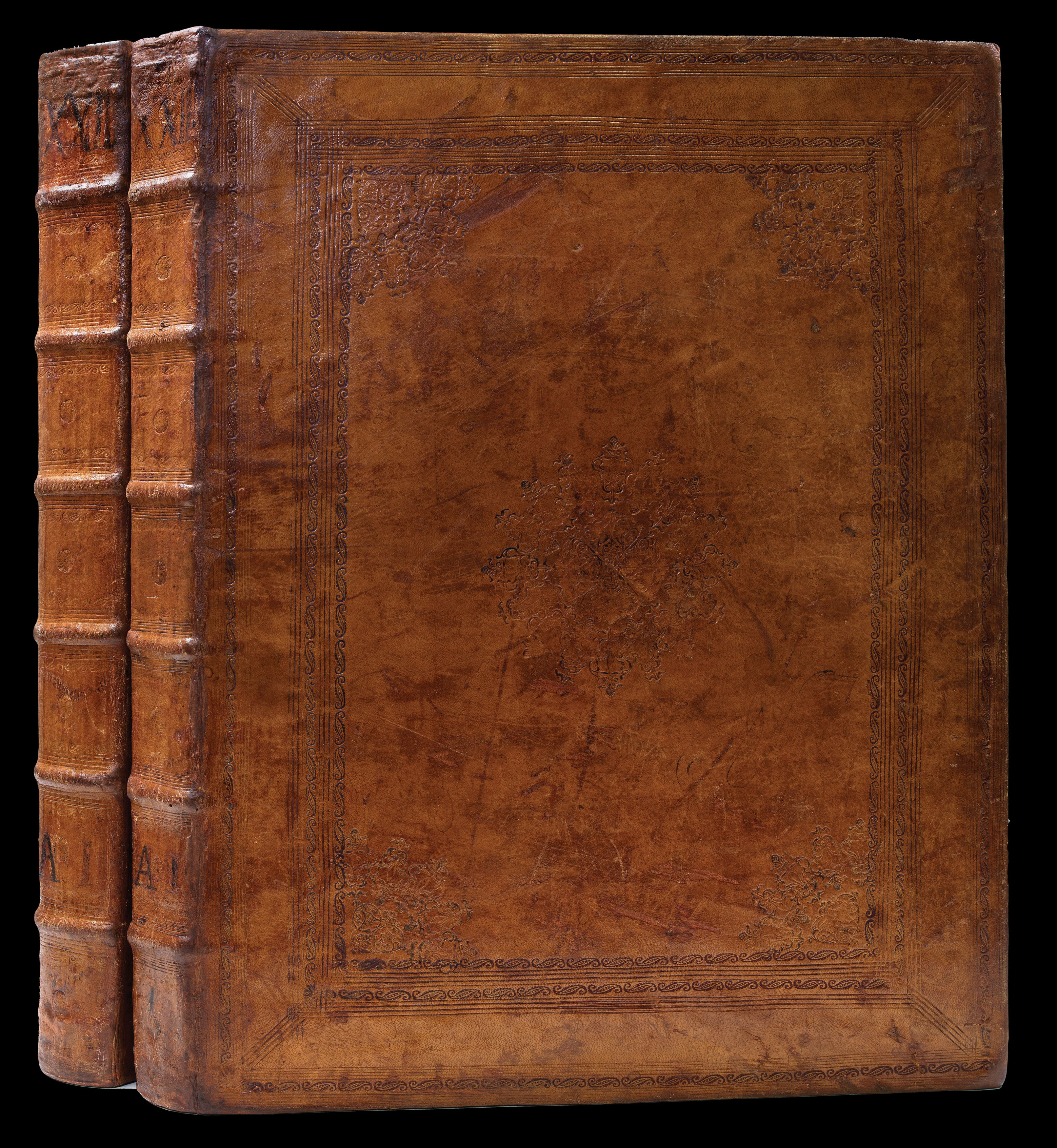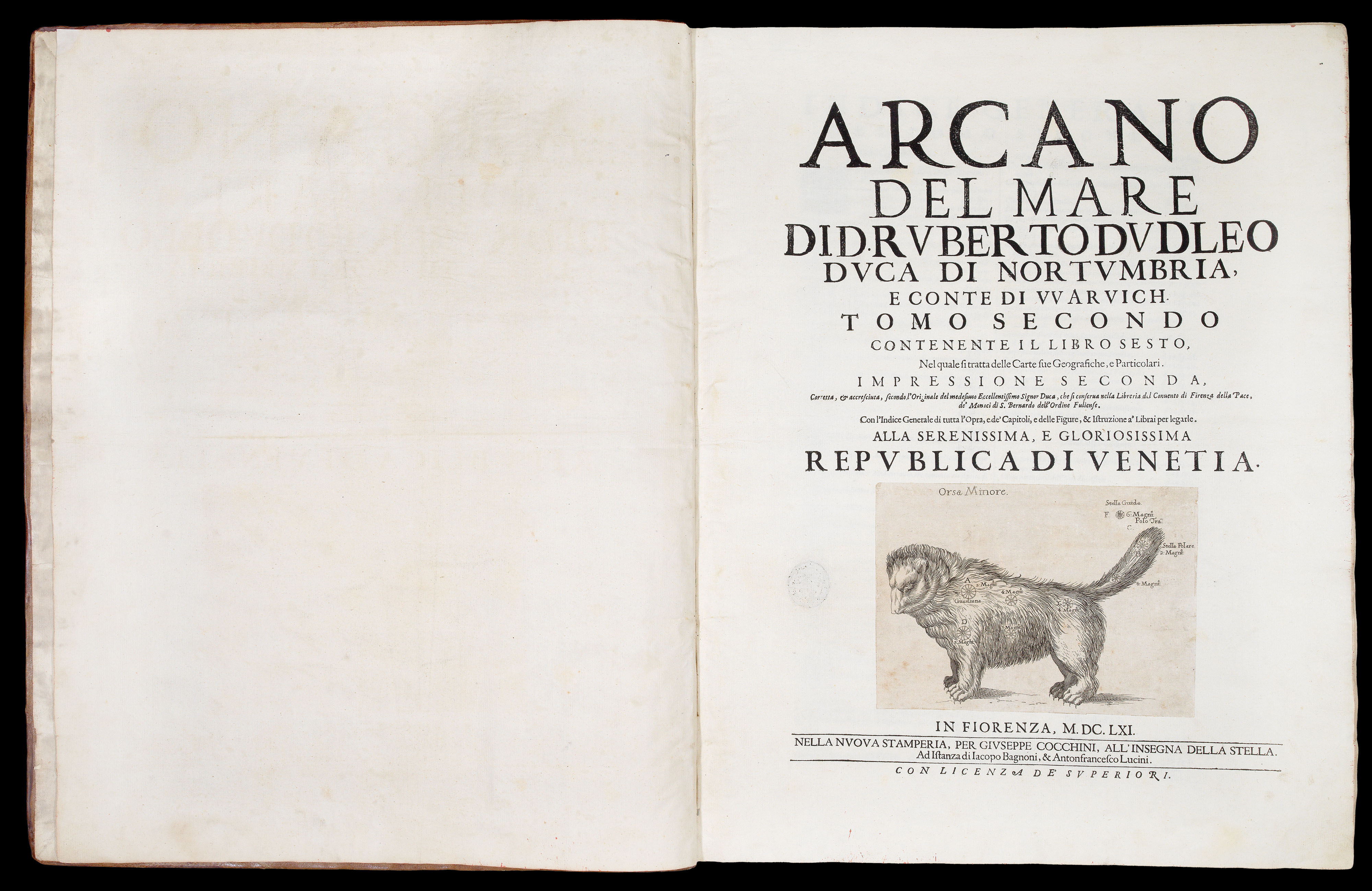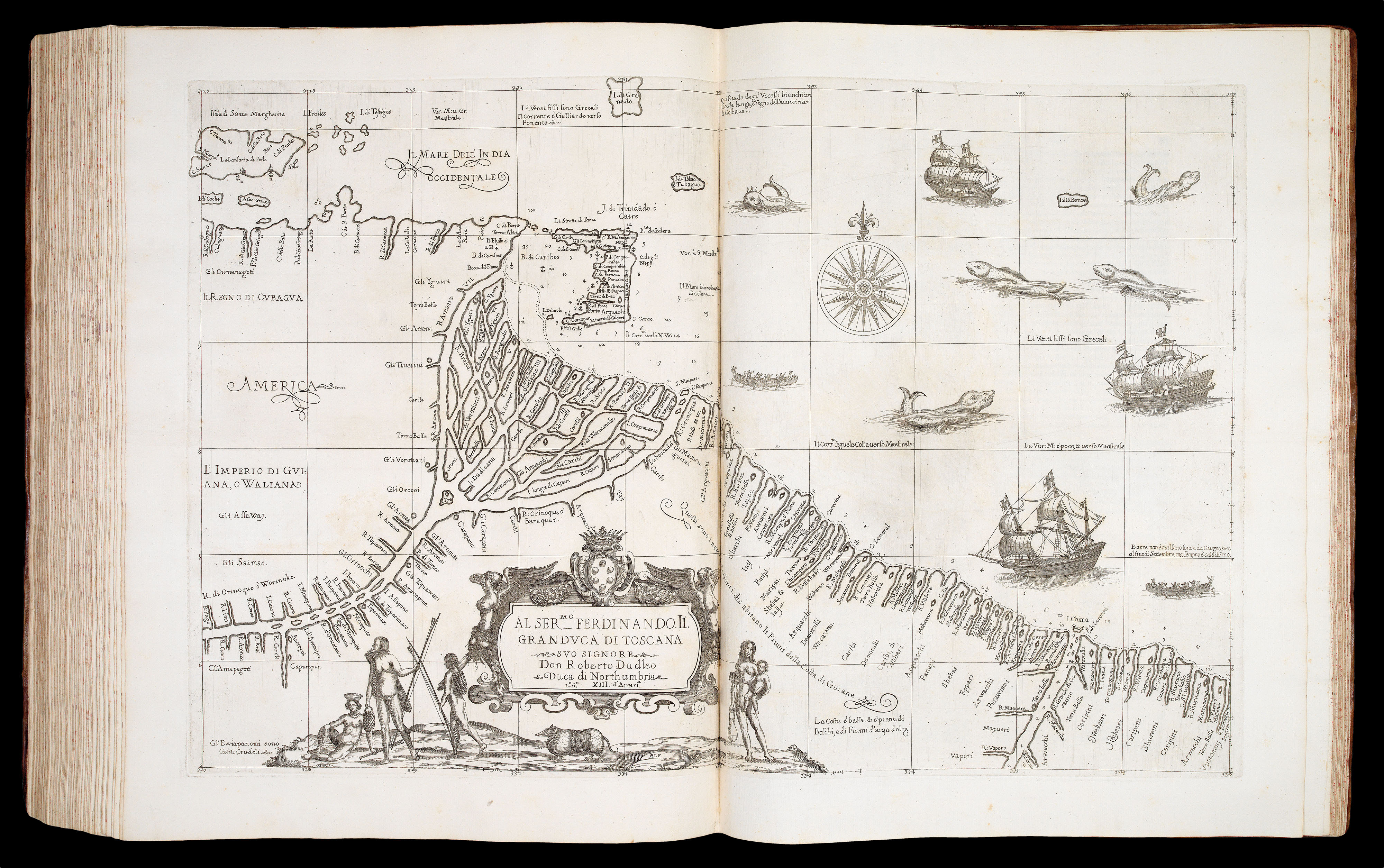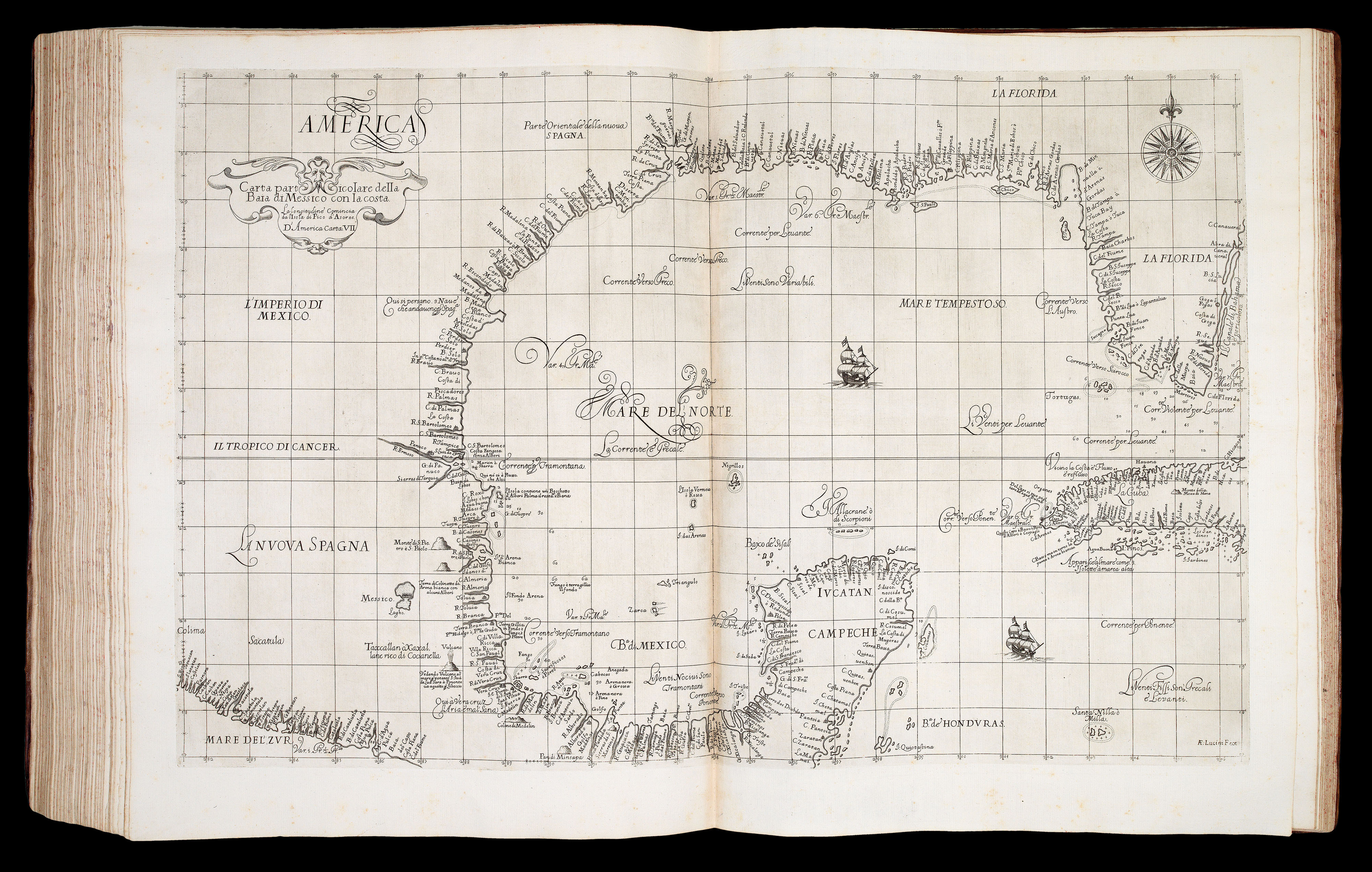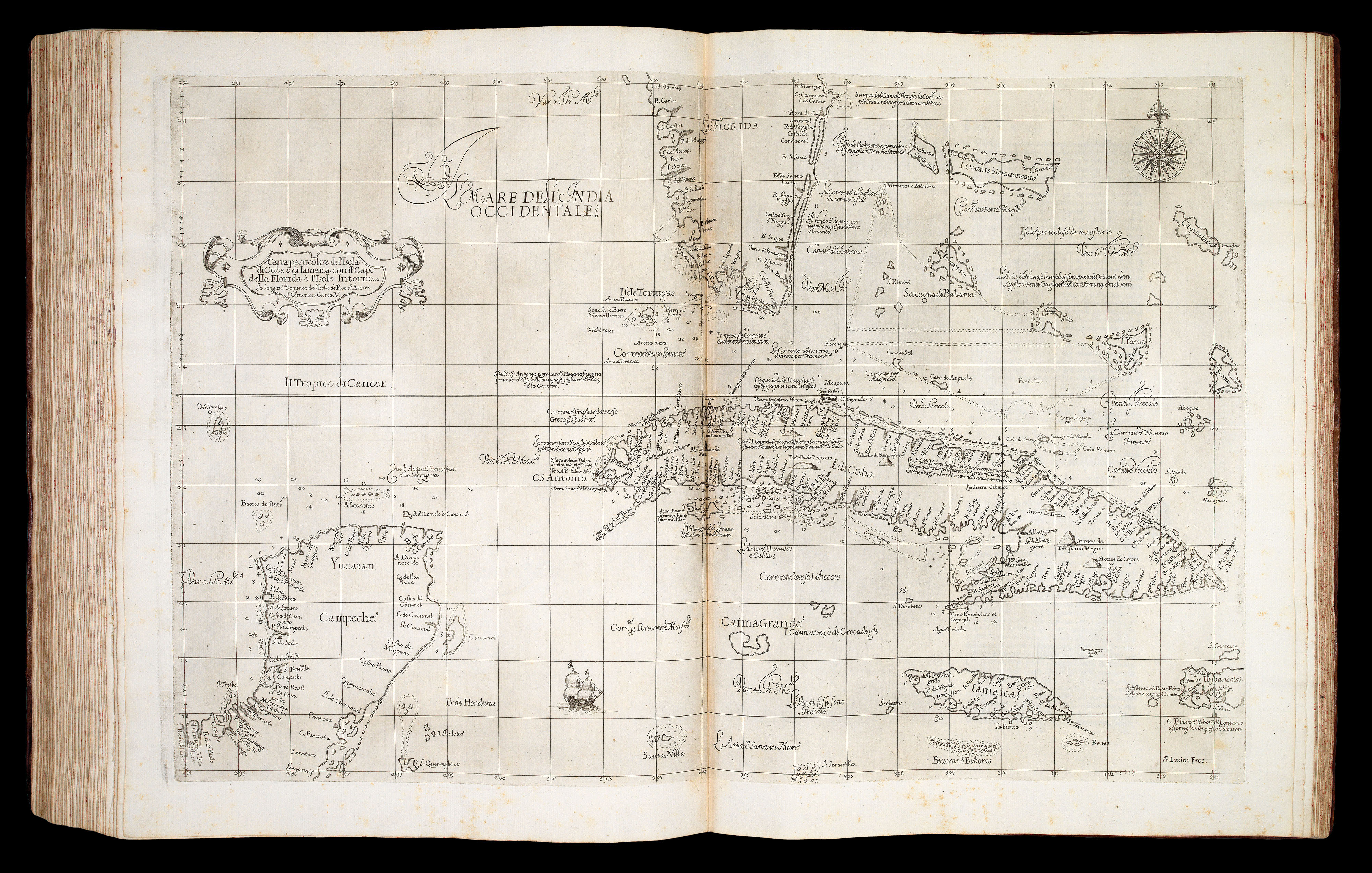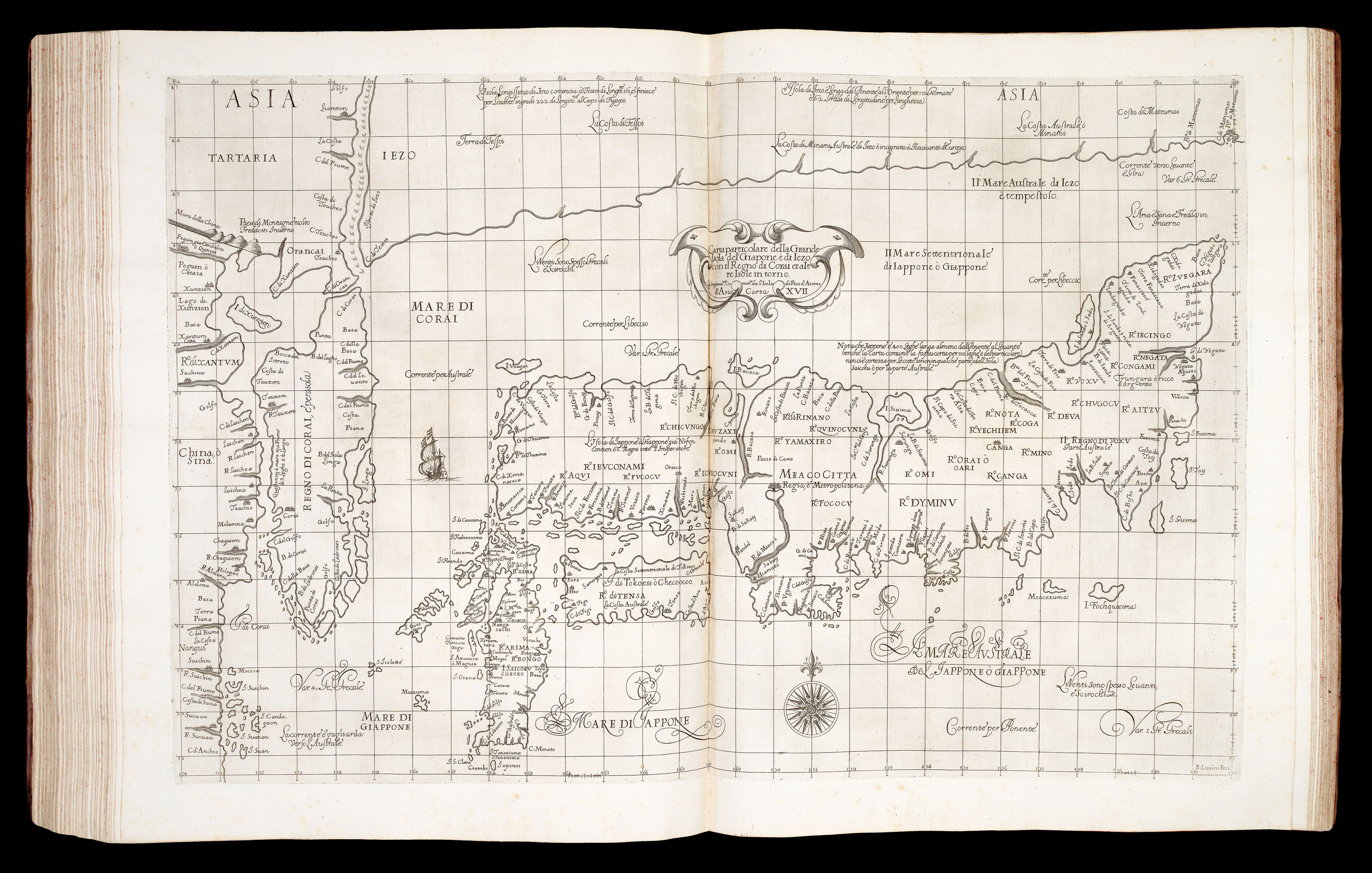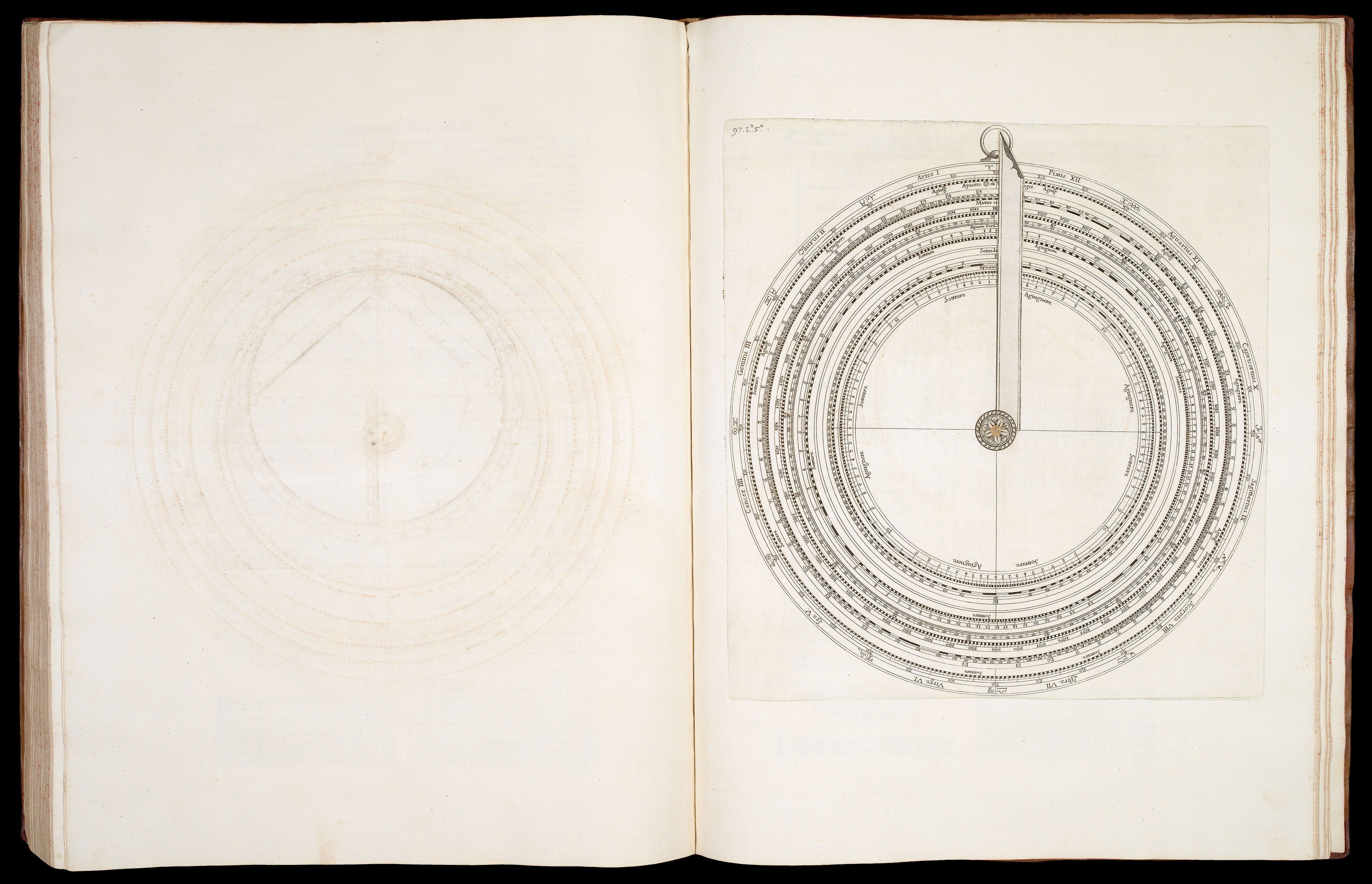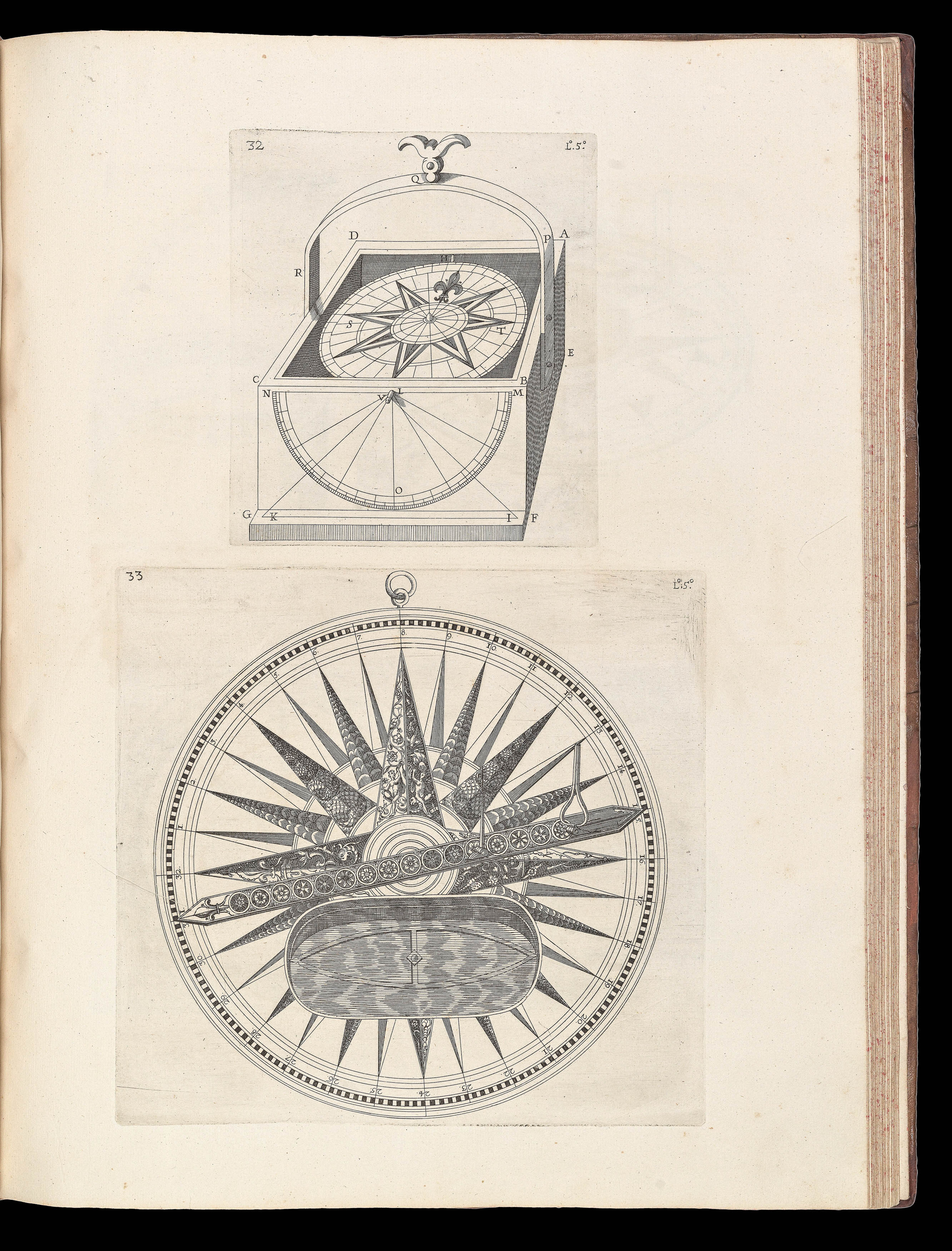The first atlas on Mercator’s Projection
Dell'arcano del Mare di D. Ruberto Dudleo Duca di Northumbria, e Conte di Warwich…
SKU: 18656
Browse World and continents
Tags: antique atlas, Cavendish, Dudley, galerato, galizaba, great circle sailing, Hudson, Lucini, Maastricht 2025, magnetic, Mercator, naval, navigation, portolano, rare atlas
Type: Rare Atlases
DUDLEY, Robert
Florence,
Giuseppe Cocchini,
1661
Six parts in two volumes. Folio (550 by 425mm), two printed titles with engraved vignettes, traces of removed library stamps, double-page plate of the author's patent of nobility, 216 engraved plates (of which 66 have volvelles or moveable parts), 146 engraved charts (of which 88 are double-page); contemporary calf, panelled, foliate roll-tool border, foliate corner and central tool, spine in seven compartments separated by raised bands.
550 by 425mm. (21.75 by 16.75 inches).
18656
To scale:
notes:
notes:
The 'Arcano de Mare' is one the "greatest atlases of the world" (Wardington). This sumptuous atlas, first published in 1646 when its author, Robert Dudley, was 73, was not only the first sea atlas of the world, but also the first to use Mercator's projection; the earliest to show magnetic deviation; the first to show currents and prevailing winds; the first to expound the advantages of 'Great Circle Sailing' – the shortest distance between two points on a globe; and "perhap...
The 'Arcano de Mare' is one the "greatest atlases of the world" (Wardington). This sumptuous atlas, first published in 1646 when its author, Robert Dudley, was 73, was not only the first sea atlas of the world, but also the first to use Mercator's projection; the earliest to show magnetic deviation; the first to show currents and prevailing winds; the first to expound the advantages of 'Great Circle Sailing' – the shortest distance between two points on a globe; and "perhaps less importantly the first sea-atlas to be compiled by an Englishman, all be it abroad in Italy" (Wardington).
Robert Dudley (1573–1649) was the son of the Earl of Leicester (the one time favourite of Elizabeth I) and Lady Douglas Sheffield, the widow of Lord Sheffield. Although born out of wedlock, Robert received the education and privileges of a Tudor nobleman. He seems to have been interested in naval matters from an early age, and in 1594, at the age of 21, he led an expedition to the Orinoco River and Guiana. He would later, like all good Tudor seamen, sack Cadiz, an achievement for which he was knighted.
His success upon the high-seas was not matched, unfortunately, by his luck at court, and at the beginning of the seventeenth century he was forced to flee, along with his cousin Elizabeth Southwell, to Europe. Eventually he ended up in Florence at the court of Grand Duke Ferdinand I of Tuscany, where he not only married his cousin and converted to Catholicism, but also help Ferdinand wage war against the Mediterranean pirates. In his spare time he set about his great life's work: the 'Arcano del Mare'.
The atlas is divided into six books, or sections: book one deals with longitude; book two covers errors in the then-existing sea charts, and includes the portolano for the Mediterranean and 15 general maps; book three deals with naval and military discipline, notably the former, and there is a long section on naval tactics, especially remarkable for a plan of the construction of a navy in five grades of vessel; book four describes the method of designing and building ships of the "Galerato" and "Galizaba" types and is concerned with naval architecture, giving the lines and dimensions of ships; book five is devoted entirely to navigation and methods of measuring the sun's declination and the relative positions of the stars; book six contains the sea atlas.
For the beautifully engraved charts, Dudley employed the services of Antonio Francesco Lucini. Lucini states in the atlases that the work took him 12 years to complete and required 5,000lbs of copper. The charts are by English and other pilots, and it is generally accepted that the work was both scientific and accurate for the time. It is assumed that Dudley used the original charts of Henry Hudson, and for the Pacific Coast of America used his brother-in-law Thomas Cavendish's observations.
Contents
Book 1. [4], 30pp., printed title with plate of a navigational instrument, [2] engraved facsimile of the Patent, 30 engravings on 28 sheets, 22 of which have moveable volvelles (of these, 2 have a string).
Book 2. 24pp., 15 engravings on nine sheets, 9 of which have volvelles, and 15 large engraved charts (six double-page or folding), of which four relate to America, five to the European coasts, four to Asia, and two to Africa.
Book 3. 25pp., 8 engraved plates on 6 sheets (three plates being of ships in battle formation, etc.) including four sheets with plates of fortifications and cities with walled defences.
Book 4. 12pp., 18 engravings on 14 sheets, of which seven are double page, all designs of ships in plan and in section.
Book 5. 26, [2]pp., 145 engravings on 89 sheets, 38 have moveable volvelles and additional 5 have a string.
Volume II
Book 6. [4], 41pp., title with plate of the Great Bear, 131 engraved charts (82 double-page), 58 covering Europe, Greenland, and Canada, 17 of Africa, 23 of Asia, and 33 of America.
Rarity
Rare. The last example to come on the market sold for £731,000 in Christies London, 2019, and, before that, $824,000 in the Frank Streeter sale, Christies New York, 2007.
Robert Dudley (1573–1649) was the son of the Earl of Leicester (the one time favourite of Elizabeth I) and Lady Douglas Sheffield, the widow of Lord Sheffield. Although born out of wedlock, Robert received the education and privileges of a Tudor nobleman. He seems to have been interested in naval matters from an early age, and in 1594, at the age of 21, he led an expedition to the Orinoco River and Guiana. He would later, like all good Tudor seamen, sack Cadiz, an achievement for which he was knighted.
His success upon the high-seas was not matched, unfortunately, by his luck at court, and at the beginning of the seventeenth century he was forced to flee, along with his cousin Elizabeth Southwell, to Europe. Eventually he ended up in Florence at the court of Grand Duke Ferdinand I of Tuscany, where he not only married his cousin and converted to Catholicism, but also help Ferdinand wage war against the Mediterranean pirates. In his spare time he set about his great life's work: the 'Arcano del Mare'.
The atlas is divided into six books, or sections: book one deals with longitude; book two covers errors in the then-existing sea charts, and includes the portolano for the Mediterranean and 15 general maps; book three deals with naval and military discipline, notably the former, and there is a long section on naval tactics, especially remarkable for a plan of the construction of a navy in five grades of vessel; book four describes the method of designing and building ships of the "Galerato" and "Galizaba" types and is concerned with naval architecture, giving the lines and dimensions of ships; book five is devoted entirely to navigation and methods of measuring the sun's declination and the relative positions of the stars; book six contains the sea atlas.
For the beautifully engraved charts, Dudley employed the services of Antonio Francesco Lucini. Lucini states in the atlases that the work took him 12 years to complete and required 5,000lbs of copper. The charts are by English and other pilots, and it is generally accepted that the work was both scientific and accurate for the time. It is assumed that Dudley used the original charts of Henry Hudson, and for the Pacific Coast of America used his brother-in-law Thomas Cavendish's observations.
Contents
Book 1. [4], 30pp., printed title with plate of a navigational instrument, [2] engraved facsimile of the Patent, 30 engravings on 28 sheets, 22 of which have moveable volvelles (of these, 2 have a string).
Book 2. 24pp., 15 engravings on nine sheets, 9 of which have volvelles, and 15 large engraved charts (six double-page or folding), of which four relate to America, five to the European coasts, four to Asia, and two to Africa.
Book 3. 25pp., 8 engraved plates on 6 sheets (three plates being of ships in battle formation, etc.) including four sheets with plates of fortifications and cities with walled defences.
Book 4. 12pp., 18 engravings on 14 sheets, of which seven are double page, all designs of ships in plan and in section.
Book 5. 26, [2]pp., 145 engravings on 89 sheets, 38 have moveable volvelles and additional 5 have a string.
Volume II
Book 6. [4], 41pp., title with plate of the Great Bear, 131 engraved charts (82 double-page), 58 covering Europe, Greenland, and Canada, 17 of Africa, 23 of Asia, and 33 of America.
Rarity
Rare. The last example to come on the market sold for £731,000 in Christies London, 2019, and, before that, $824,000 in the Frank Streeter sale, Christies New York, 2007.
bibliography:
bibliography:
Phillips [Atlases], 457, 458, and 3428; cf. Shirley [Atlases], M.DUD-1a-1e; Wardington, 199-211.
provenance:
provenance:
Provenance
1. Sir John Temple Leader (1879-1903); first Villa Maiano, and then at the Castello di Vincigliata near Fiesole, which he purchased in 1855 and restored in neo-medieval style, furnishing and richly embellishing it with paintings and furniture of the fourteenth and fifteenth centuries.
Leader possessed both the first and second editions of Dudley's 'Dell'Arcano dell mare', and Dudley's manuscript, the 'Direttorio Marittimo'. He describes his relationship with Pietro Bigazzi, the Florentine bookdealer from whom he purchased all three items, in his biography of Dudley: "Long ago I bought from Signor Pietro Bigazzi, together with many other books which had belonged to Dudley, the first two volumes and the fourth of the 'Arcano del Mare', the first edition of his great work which was published at Florence in 1646-47. The third volume was wanting, perhaps lent to some friend who had forgotten to return it. Two or more years after this, Signor Bigazzi brought me, as a New Year's gift, the missing volume of this very same incomplete set. He had discovered it on the low wall or ledge of the Palazzo Riccardi, and bought it from the salesman who had permission to sell his books there. My joy on thus unexpectedly receiving the missing part may be easily imagined by collectors and lovers of old books. The four volumes thus happily reunited after a long separation were in the old binding with the arms of a Cardinal of the Medici family" (pages 18-19).
2. By descent to Richard Luttrell Pilkington Bethell, 3rd Baron Westbury (1903-1917), who sold Leader's collections "piecemeal".
1. Sir John Temple Leader (1879-1903); first Villa Maiano, and then at the Castello di Vincigliata near Fiesole, which he purchased in 1855 and restored in neo-medieval style, furnishing and richly embellishing it with paintings and furniture of the fourteenth and fifteenth centuries.
Leader possessed both the first and second editions of Dudley's 'Dell'Arcano dell mare', and Dudley's manuscript, the 'Direttorio Marittimo'. He describes his relationship with Pietro Bigazzi, the Florentine bookdealer from whom he purchased all three items, in his biography of Dudley: "Long ago I bought from Signor Pietro Bigazzi, together with many other books which had belonged to Dudley, the first two volumes and the fourth of the 'Arcano del Mare', the first edition of his great work which was published at Florence in 1646-47. The third volume was wanting, perhaps lent to some friend who had forgotten to return it. Two or more years after this, Signor Bigazzi brought me, as a New Year's gift, the missing volume of this very same incomplete set. He had discovered it on the low wall or ledge of the Palazzo Riccardi, and bought it from the salesman who had permission to sell his books there. My joy on thus unexpectedly receiving the missing part may be easily imagined by collectors and lovers of old books. The four volumes thus happily reunited after a long separation were in the old binding with the arms of a Cardinal of the Medici family" (pages 18-19).
2. By descent to Richard Luttrell Pilkington Bethell, 3rd Baron Westbury (1903-1917), who sold Leader's collections "piecemeal".






